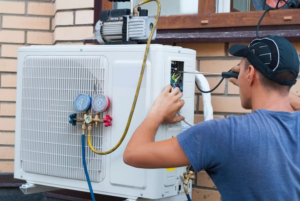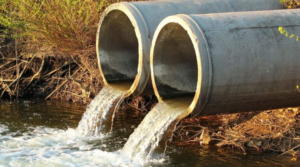Commercial plumbing deals with large-scale systems that are housed in buildings like hotels and hospitals. These systems have to comply with different building codes than residential plumbing.

Leaky taps can cause serious problems for businesses that rely on water supplies. They can waste huge amounts of money and damage the environment. Leaking pipes in restaurants and hospitals can also lead to health violations. Get in touch with Plumber Woodland Hills for professional support.
A commercial plumber is a specialist who works on plumbing systems in buildings such as schools, hospitals, malls and office complexes. These systems are typically larger and more complicated than plumbing in a home. These systems are used by a lot more people, so they’re more likely to experience issues like water leaks and blocked drains. This is why it’s important to hire a reputable and experienced commercial plumber for your business.
Commercial plumbing services include the design, installation, inspection and repair of piping and fixtures in commercial properties such as malls, restaurants, hotels, offices, and hospitals. They work with different types of piping, including copper and PVC, as well as various tools and equipment. Some of the tasks they complete include installing sanitary and storm drainage systems, fittings, and valves. They also troubleshoot problems and perform routine maintenance.
Because of the size and scope of their jobs, commercial plumbers often have more responsibilities than residential plumbers. For example, they must be able to follow building plans and designs when working on large-scale projects. They also have to deal with a higher volume of usage, as many of these buildings are used by hundreds of people on a daily basis.
Moreover, they must be willing to travel long distances and spend more time on each job than their residential counterparts. This is because their clientele consists of businesses that can’t close for extended periods of time, such as hospitals and shopping centers. This means that they must be available to provide services whenever their clients need them.
Another challenge is that commercial plumbers must be able to negotiate with building owners. They may need to convince them that their services are needed before they can begin repairs. This can be difficult, especially if the building is a high-rise or has sensitive security concerns. For instance, if a plumber discovers a water leak in the kitchen of a hotel, they may need to contact a manager or the general contractor before they can access the area.
Commercial plumbing is a highly specialized field that requires training and certification. Unlike residential plumbers, who usually work with basic household plumbing systems, commercial plumbers must be able to deal with industrial-scale water heaters and larger pipes. They also must be familiar with local plumbing codes and regulations.
Training requirements
Commercial plumbers perform a variety of tasks, including installing, repairing, and maintaining plumbing systems in businesses, restaurants, and other large establishments. These tasks require a variety of skills and training, which can be acquired through formal apprenticeship programs and on-the-job experience. In addition, commercial plumbers often work in collaboration with builders and architects on large-scale projects. This work requires a strong understanding of building codes and standards, as well as the ability to read blueprints.
Many states require plumbers to hold a license before practicing their trade. Typically, this process involves passing an exam and completing continuing education (CE) courses to stay up-to-date on industry best practices. Continuing education courses also help plumbers expand their skills and find new opportunities to practice their trade.
The training requirements for a commercial plumber vary by state, but most require a high school diploma or equivalent. Prospective plumbers must also complete a formal apprenticeship program, which is overseen by a licensed master plumber. This type of apprenticeship can last 4-5 years and includes on-the-job training as well as classroom instruction. Some high schools offer CTE programs that lead directly to apprenticeships, while other organizations offer a variety of apprentice opportunities throughout the state.
Aspiring commercial plumbers may also opt to take specialized training courses offered by manufacturers or other educational institutions. These courses can help them gain experience in a specific area of the field, making them more competitive when applying for jobs. In some cases, these specialized certifications are mandatory for certain responsibilities or applications, such as medical gas systems.
A commercial plumber is also responsible for assembling and installing different types of water, heating, and drainage systems. This can involve working with pipes made of copper, PEX, or CPVC. They may also install fixtures and equipment like sinks, faucets, bathtubs, showers, and toilets. Commercial plumbers are also tasked with maintaining these systems, so they must be familiar with a wide range of tools and pipe fittings. They also need to know how to troubleshoot problems and solve complex issues. In addition to their normal duties, they must often work outside of business hours and be prepared for emergency calls.
Skills required
Plumbing is a highly skilled profession, and commercial plumbers are responsible for maintaining, repairing and installing plumbing systems in business facilities. These professionals often deal with larger, more complex plumbing systems than residential plumbers, and are expected to have a full understanding of local plumbing laws and standards. They also need to be able to read blueprints and understand technical designs. In addition, they must be able to work safely at heights and on large-scale projects.
A career as a commercial plumber is challenging, but it offers greater earning potential and the opportunity to work on bigger projects than residential plumbing. However, it is important to research the market before deciding to specialise in commercial or residential plumbing. Many vocational schools and community colleges offer courses in plumbing, and these can be helpful in starting a career as a plumber. These programs teach basic skills like reading blueprints, safety practices and plumbing theory.
In addition to their technical knowledge, commercial plumbers need excellent problem-solving skills. They must be able to identify and repair issues quickly, so that they do not impact company operations or revenue. They must also be able to work effectively in tight spaces, with a variety of tools and equipment. For example, they may have to fit a pipe in an extremely narrow space between two walls.
Moreover, the work environment of a commercial plumber can be very hazardous. They are often exposed to fumes and dangerous chemicals, and must wear protective equipment at all times. They also work at extreme heights on building frames and infrastructure, and must be trained in safe working procedures for high-risk worksites. In addition, they must be able deal with complex industrial plumbing systems and steam and chemical transportation lines.
Another important skill for commercial plumbers is the ability to meet deadlines. They are required to complete the job on time, or they will be fined. This is especially important for projects that are time-sensitive and costly, such as emergency repairs in hospitals. Similarly, they must be able to manage the demands of their clients and ensure that they are satisfied with their services.
Work environment
The work environment for a commercial plumber is a little different from that of residential plumbers. While both types of plumbers are responsible for installing, maintaining, and troubleshooting plumbing systems, commercial plumbers often have more responsibilities and work with a wider range of clients. Commercial plumbers also work with larger public systems, such as schools and shopping centers. These systems are often more complex than those found in homes, so they require more maintenance and repairs.
In addition to repairing plumbing fixtures and pipes, commercial plumbers also install new ones. The systems they install must be able to handle the higher volume of water used by commercial customers. They also must meet governmental construction standards and regulations. In some cases, commercial plumbers may need to consult with engineers or architects to design a plumbing system that meets the specific needs of their client’s building.
One difference between residential and commercial plumbing is that residential plumbers typically deal with the owner of a home or the primary user of a bathroom. Commercial plumbers, on the other hand, are more likely to work with businesses or other corporate clients. They may be required to schedule appointments outside of business hours to shut off the building’s water supply and make necessary repairs.
Another difference is that commercial plumbing systems are more prone to damage than residential ones. They are also more likely to experience problems, such as clogged drains and toilets. These issues can be very disruptive to the flow of a business and affect productivity. For example, a restaurant may lose revenue if it can’t offer restroom services to its customers.
When hiring a commercial plumber, consider their reputation and past work history. You should also look for a company that offers transparent pricing and a warranty on their work. You should also ask about their availability and if they have any other services available, such as cleaning or emergency plumbing. Finally, a good commercial plumber will be reliable and dependable. They should also be available at your convenience and respond quickly to your inquiries.

